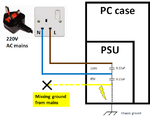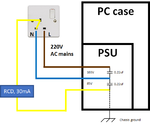
- Joined
- Jul 4, 2009
- Messages
- 16,489
- Helped
- 5,157
- Reputation
- 10,347
- Reaction score
- 5,207
- Trophy points
- 1,393
- Location
- Aberdyfi, West Wales, UK
- Activity points
- 139,504
Neutral and Earth are usually bonded together but not at the socket, it is done back at the distribution transformer where both have a real 'planet Earth' ground. If you bond them at the socket and a fault occurs, the earth pin could become live and hence extremely dangerous. Consider what would happen if the neutral connection back to the box went open circuit, your PC would stop working but the case would be at 230V AC!
I do actually have a 125A 3-phase mains supply here but it is unusual in the UK and I only use one phase and neutral within the house. In most places the neutral and rotating phase connections are outside the property at the buried distribution cable.
Brian.
Each room here is wired in a ring, Earth, live and Neutral arrive at the first socket, are wired to the next socket and at the end of the ring all three return to the fuse box where they are wired in parallel with the first wires. It means there are two paths for current to flow (two directions around the loop) which gives half the resistance and better protection if a break occurs. Part of the statutory electrical inspection is to break the loop and measure the resistance around it to confirm connectivity. For a single room with (in my case) 8 outlets, the live and neutral are 2.5mm2 solid copper. the Earth wire is slightly thinner, I would guess 1.5mm and the trip rating is 32A. I have 'real' Earth points to 1m long copper rods at each side of the house as well as the connection back to the transformer. The long pin on the 13A rated UK sockets is the Earth pin, the extra length ensures it connects before live and neutral and it also opens a shutter mechanism in the sockets that otherwise closes off the holes for live and neutral.Q: Do you have a ring feed in your home/apartment? What is the purpose of middle contact (longer one) on UK type mains plug?
I do actually have a 125A 3-phase mains supply here but it is unusual in the UK and I only use one phase and neutral within the house. In most places the neutral and rotating phase connections are outside the property at the buried distribution cable.
Brian.























